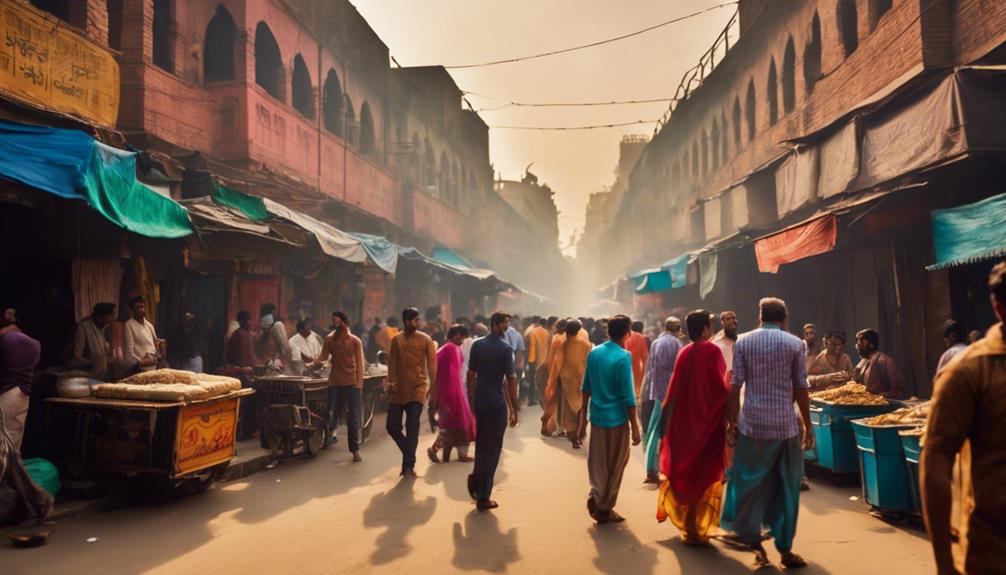As you step into the vibrant streets of Old Delhi, you're about to unravel a treasure trove of historic landmarks, bustling markets, and serene oases that will transport you through the city's rich cultural heritage. Explore Qutub Minar's towering grandeur, marvel at Jama Masjid's intricate marble inlay work, and get lost in Chandni Chowk's kaleidoscope of colors and aromas. Discover the peaceful ambiance of Shri Digamber Jain Mandir and Raj Ghat, and uncover the secrets of Old Delhi's ancient history. And, if you venture further, you'll uncover even more hidden gems waiting to be discovered.
Key Takeaways
- Explore the iconic Qutub Minar, a UNESCO World Heritage Site and the world's tallest brick minaret, showcasing Indo-Islamic architecture.
- Visit Jama Masjid, a majestic Mughal-era mosque featuring intricate marble inlay work and Arabic calligraphy.
- Wander through Chandni Chowk, a vibrant marketplace offering a kaleidoscope of colors, sounds, and aromas, with a treasure trove of shopping delights.
- Discover the serene Shri Digamber Jain Mandir, a peaceful oasis amidst Old Delhi's chaos, featuring stunning architecture and Jain artifacts.
- Unwind in the historic streets of Old Delhi, where ancient monuments, bustling markets, and delectable cuisine await discovery.
Qutub Minar's Tallest Brick
As you approach the Qutub Minar, you can't help but be awestruck by its towering presence. You're about to explore the world's tallest brick minaret, a marvel of medieval engineering that has withstood the test of time. From its stunning architectural design to the best time to visit, let's uncover the secrets of this iconic monument, and don't forget to wear comfortable walking shoes for the adventure ahead!
Overview
Standing tall at an astonishing 72.5 meters, Qutub Minar's brick minaret pierces the Delhi sky, its staggering height and intricate carvings beckoning you to explore the rich history within. As you approach this magnificent structure, you'll be struck by its sheer scale and the intricate details that adorn its surface. Built by Qutb-ud-din Aibak, the founder of the Delhi Sultanate, in 1192, this UNESCO World Heritage Site is a monument to the city's rich cultural significance. You'll discover that the minaret's red sandstone and white marble exterior is covered in intricate carvings and inscriptions from the Quran, showcasing the blending of Islamic and Indian architectural styles.
As you venture deeper into the Qutub Minar complex, you'll uncover the rich Delhi history that lies within. The complex houses several ancient monuments, including the Quwwat-ul-Islam Mosque, the Alai Minar, and the Iron Pillar. With millions of visitors flocking to this site each year, it's clear that Qutub Minar is an unmissable destination for anyone looking to explore the cultural significance of Old Delhi.
Minaret's Stunning Architectural Design
You're immediately struck by Qutub Minar's stunning architectural design, a masterful blend of Indo-Islamic and Afghan styles that showcases intricate carvings, calligraphy, and ornate decorations. As you stand before this towering structure, you can't help but marvel at the intricate details that adorn its surface. The minaret's design is inspired by the Minaret of Jam in Afghanistan, and its ancient inspirations are evident in the intricate carvings and inscriptions that cover its surface. Passages from the Quran, as well as the names of various Sultans and nobles, are skillfully etched into the stone, a demonstration of the Islamic influences that shaped its construction. The minaret's towering height, an impressive 72.5 meters, is a reflection of the engineering prowess of its builders. Despite being damaged by earthquakes, Qutub Minar remains an iconic symbol of Delhi's rich history and cultural heritage, a must-visit destination for anyone exploring Old Delhi.
Best Time To Visit
Before you plan your visit to Qutub Minar, consider the best time to explore this iconic monument, when the weather is mild and comfortable, allowing you to fully appreciate its towering presence. The best time to visit Qutub Minar is from October to March, when the weather forecast is pleasant, with average temperatures ranging from 12°C to 25°C. This period marks the peak tourist season, with a gentle winter breeze that makes exploring the monument a delight. During this time, you'll be able to take in the intricate carvings and stunning architecture of the minaret without the sweltering heat of the summer months. Additionally, the mild weather will allow you to take your time exploring the surrounding complex, including the beautiful Alai Minar and the Iron Pillar. Avoid visiting during the summer months, when the temperatures soar above 40°C, making it difficult to fully appreciate the monument's grandeur. By planning your visit during the peak tourist season, you'll be able to make the most of your trip to Qutub Minar.
Wear Comfortable Walking Shoes
As you prepare to tackle Qutub Minar's towering 379-step spiral staircase, make sure to lace up comfortable walking shoes that can handle the climb. You'll want to prioritize Sole Care to avoid Foot Pain, which can quickly ruin your day. The last thing you want is to be halfway up the minaret, wincing in discomfort, and regretting your shoe choice.
Opt for shoes with good arch support, cushioning, and traction to help you navigate the narrow, winding staircase. You'll be grateful for the extra comfort as you ascend the 72.5-meter-tall structure, taking in the stunning views of Old Delhi. Remember, the climb is worth it – the panoramic views from the top are breathtaking! So, don't let footwear woes hold you back. Wear comfortable walking shoes, and you'll be ready to conquer Qutub Minar's tallest brick structure with ease. Your feet (and the rest of you) will thank you.
Jama Masjid's Grand Dome
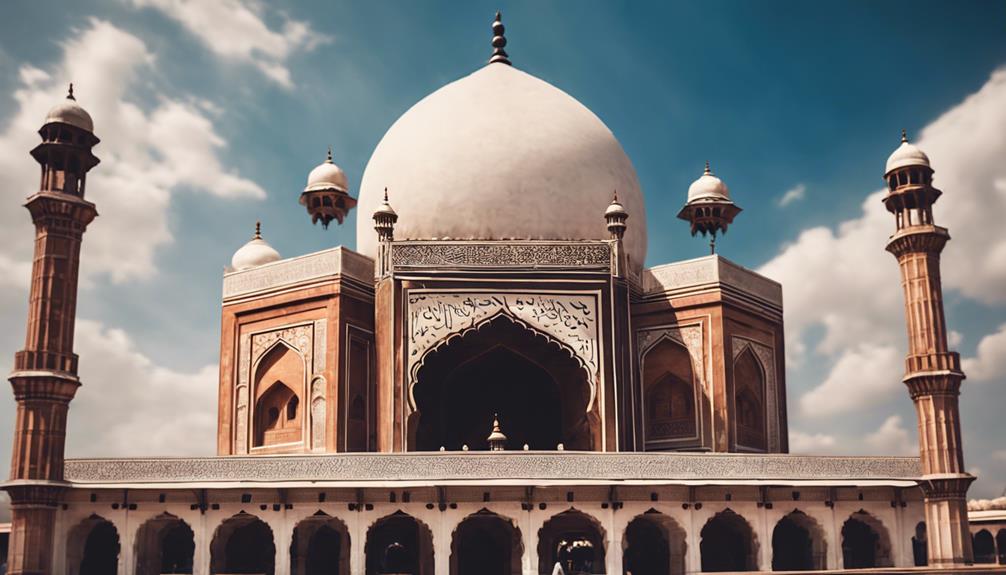
As you step into the majestic Jama Masjid, your eyes will be drawn to the stunning grand dome that dominates the mosque's landscape. You'll be fascinated by the intricate marble inlay work that adorns the dome, a reflection of the skill of the artisans who built this Mughal-era masterpiece. As you explore the dome's beauty, you'll want to know more about its intricate design, the best time to visit, and how to prepare for your visit.
Overview
Standing in the heart of Old Delhi, Jama Masjid's grand dome rises majestically, its towering presence a symbol to the rich cultural heritage of the city. As you approach the mosque, you can't help but be awed by the sheer scale and beauty of the dome, which dominates the surrounding landscape. Built by Shah Jahan in 1656, this stunning monument is an integral part of Delhi's history and cultural significance. The dome's grandeur is a tribute to the architectural genius of the Mughal Empire, which left an indelible mark on the city's cultural landscape. As you walk around the mosque, you'll notice the intricate marble inlays, ornate carvings, and Arabic calligraphy that adorn the interior of the dome. The attention to detail and craftsmanship are a demonstration of the skill of the artisans who built this magnificent structure. As you take in the sights and sounds of Jama Masjid, you'll begin to appreciate the rich cultural heritage of Old Delhi, and the significant role that this iconic monument plays in the city's history.
Intricate Marble Inlay Work
The grand dome of Jama Masjid rises before you, its intricate marble inlay work a dazzling display of Mughal craftsmanship, transporting you to an era of elegance and refinement. As you gaze up at the dome, you can't help but marvel at the thousands of tiny pieces of marble, carefully arranged to create intricate floral patterns and Arabic calligraphy. The marble used in the inlay work was brought from the nearby town of Makrana, famous for its high-quality white marble, a favorite of Mughal Emperor Shah Jahan. The level of precision and detail achieved by the craftsmen is astounding, and the design on the dome is not only aesthetically pleasing but also has spiritual significance, symbolizing the beauty and perfection of Allah's creation. The inlay techniques used to create this masterpiece are a demonstration of the skill of the artisans who worked on the mosque. The marble craftsmanship on display is truly breathtaking, and you can't help but feel a sense of awe at the mastery of Mughal artisans.
Best Time To Visit
You'll want to time your visit to Jama Masjid's grand dome strategically, since the right lighting can elevate your experience and make the intricate marble inlay work truly shine. Aim for early morning or late afternoon when the sun's soft rays highlight the dome's majestic beauty. Avoid visiting during the peak of the day when the harsh sunlight can create unflattering shadows. If you're planning your trip during the Monsoon season, be prepared for sudden downpours, but also take advantage of the cooler temperatures and lush green surroundings. Try to steer clear of weekends and holidays when the tourist rush is at its peak, and you'll have a more peaceful experience. The best time to visit Jama Masjid is from October to March when the weather is mild and pleasant, making it ideal for exploring the grand dome and its surroundings. By planning your visit strategically, you'll be rewarded with an unforgettable experience amidst the grandeur of Jama Masjid.
Wear Sunscreen and Hats
As you prepare to marvel at Jama Masjid's grand dome, slather on sunscreen and don a hat to shield yourself from the intense Delhi sun, which can quickly turn a memorable experience into a painful ordeal. Delhi's scorching heat can be unforgiving, especially during the peak summer months. Without proper sun protection, you'll be risking sunburn, heat exhaustion, or even heatstroke.
Chandni Chowk's Bustling Streets

As you step into Chandni Chowk's bustling streets, you're immediately immersed in a kaleidoscope of colors, sounds, and aromas. You'll want to soak up the vibrant atmosphere, sampling the street food, exploring the shops, and taking in the historic landmarks. To make the most of your visit, you should prioritize knowing the best times to go, what to eat, and how to stay hydrated in this bustling hub.
Overview
What awaits you in Chandni Chowk's bustling streets is an unforgettable sensory overload, where the cacophony of sounds, kaleidoscope of colors, and medley of aromas blend together to create an experience that's quintessentially Old Delhi. As you navigate through the crowded streets, you'll be immersed in the local culture, where traditional and modern shopping experiences blend seamlessly. You'll find everything from spices and dry fruits to jewelry and electronics lining the streets. In the evenings, the night markets come alive, offering a treasure trove of shopping delights. The air is thick with the aromas of street food, tempting your taste buds, but for now, let's focus on the sights and sounds. The vibrant atmosphere is infectious, and you can't help but get caught up in the energy of the place. With its unique blend of old and new, Chandni Chowk is a must-visit destination for anyone looking to experience the authentic charm of Old Delhi. So, take a deep breath, and plunge into the chaos – you won't be disappointed!
Vibrant Street Food Scene
You're about to venture on a culinary adventure through Chandni Chowk's bustling streets, where the aromas of sizzling street food waft through the air, teasing your taste buds and beckoning you to indulge in the vibrant street food scene. Get ready to set out on a foodie adventure like no other! Chandni Chowk, one of the oldest and busiest markets in Old Delhi, is a haven for culinary delights. Paranthewali Galli, a narrow alleyway, is a must-visit for its mind-boggling array of parathas – over 30 types to be exact! From crispy papad to flavorful tomato, every flavor is a surprise. And the best part? Most dishes are super affordable, ranging from ₹20 to ₹50 (approximately $0.25 to $0.65 USD). Be sure to stop by Natraj Dahi Bhalla Corner for a quick bite of crispy dahi bhalla and aloo tikki. If you're in the mood for a heartier meal, Al Jawahar is a great spot for rich Mughlai and North Indian dishes. With so many options, your taste buds will thank you for this foodie adventure!
Best Time To Visit
Timing is everything when exploring Chandni Chowk's bustling streets, and planning your visit during the cooler winter months (October to February) guarantees a more comfortable experience amidst the chaos. You'll appreciate the mild temperatures, ranging from 10°C to 20°C, making it perfect for walking and exploring the area. Avoid visiting during the scorching summer months (April to June) when the temperature can soar up to 45°C, making it challenging to navigate the crowded streets.
Before planning your visit, be sure to check the Weather Forecast to verify you're prepared for any unexpected rain showers or extreme temperatures. To make the most of your time, consider using the Delhi Metro to reach Chandni Chowk; the Chandni Chowk metro station is conveniently located near the Red Fort, making it an ideal starting point for your exploration. By planning your visit strategically, you'll be able to take in the sights, sounds, and flavors of Chandni Chowk without the discomfort of extreme weather conditions. With a little planning, you'll be ready to immerse yourself in the vibrant atmosphere of Old Delhi!
Carry Refillable Water Bottles
As you navigate Chandni Chowk's labyrinthine streets, it's easy to get caught up in the whirlwind of sights, sounds, and aromas, but don't forget to prioritize your own comfort and hydration by carrying a refillable water bottle. The crowded streets and humid climate can quickly dehydrate you, making it essential to stay hydrated throughout your visit. Carrying a refillable water bottle is not only a hydration tip but also a water conservation effort. You'll find plenty of water refill stations throughout the area, making it convenient to refill and reuse your bottle. By doing so, you'll reduce your plastic waste and contribute to a more sustainable tourism experience. Remember to take regular breaks to rest and rehydrate, especially during the peak summer months. With your refillable water bottle in hand, you'll be well-equipped to tackle the vibrant atmosphere of Chandni Chowk and make the most of your visit to this iconic Old Delhi destination.
Shri Digamber Jain Mandir
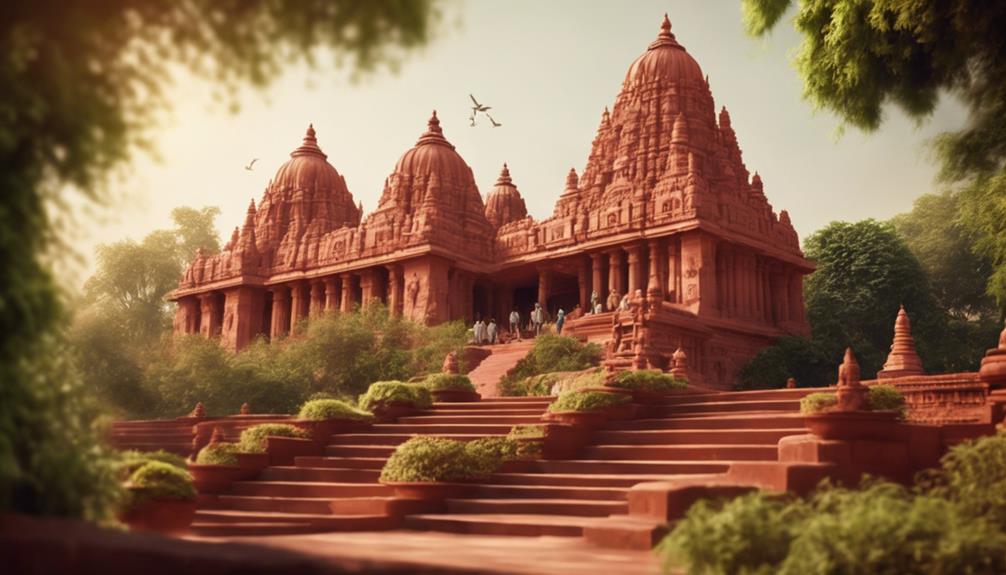
As you make your way to Shri Digamber Jain Mandir, you're about to enter a serene oasis amidst Old Delhi's chaos. You'll soon discover the temple's stunning architecture, adorned with intricate carvings and ornate details that'll leave you in awe. Get ready to explore this Jain temple's treasures, from its beautifully crafted idols to the best times to visit and the respectful silence that fills the air.
Overview
Located in the heart of Old Delhi, you'll stumble upon the breathtaking Shri Digambar Jain Lal Mandir, a stunning Jain temple that embodies serene beauty and fascinating history. As you step inside, you'll be struck by the temple's intricate architecture, which is a perfect blend of Jain Culture and Indian craftsmanship. The temple's design is a reflection of the rich heritage of Jainism, with its ornate pillars, beautifully carved sculptures, and vibrant frescoes adorning the walls.
As you explore the temple complex, you'll discover a treasure trove of Jain artifacts, manuscripts, and sculptures on display at the in-house museum. This treasure trove offers a glimpse into the history and philosophy of Jainism, allowing you to explore further into the temple's significance. The temple's courtyard, with its intricate carvings and beautiful sculptures, is a photographer's delight. Whether you're interested in exploring Jainism or simply seeking a peaceful oasis in the midst of bustling Old Delhi, the Shri Digambar Jain Lal Mandir is a must-visit destination that promises to leave you enchanted.
Intricately Carved Jain Idols
Inside the Shri Digambar Jain Lal Mandir, you'll find yourself surrounded by over 200 intricately carved Jain idols, each one a masterpiece of Indian craftsmanship, showcasing the exceptional skill of Jain artisans. As you walk through the temple, you'll be struck by the level of detail and precision that has gone into crafting each idol. According to Jain philosophy, these idols represent the ideals of non-violence, self-control, and spiritual purification. The idols are significant not only for their aesthetic appeal but also for their spiritual significance. They serve as a reminder of the Jain principles of Ahimsa (non-violence) and Anekantavada (multiplicity of viewpoints). The idol significance lies in their ability to inspire devotion and spiritual growth in those who worship them. As you take in the beauty of these idols, you'll gain a deeper understanding of the Jain way of life and the importance of these sacred symbols in Jainism.
Best Time To Visit
You'll want to plan your visit to Shri Digambar Jain Lal Mandir during the winter months, from October to March, when the comfortable temperatures and gentle sunshine make for a peaceful and contemplative atmosphere. This is the best time to explore the intricacies of the temple, taking in the serene ambiance that permeates every corner of this sacred space. During these months, the temperatures range from 10°C to 25°C, making it ideal for a leisurely stroll around the temple complex. Avoid visiting during the summer vacations, when the scorching heat can be overwhelming. Additionally, try to plan your visit around festival seasons, when the temple is decorated with vibrant colors and the atmosphere is electric. The gentle winter sun and cool breeze will make your visit a truly unforgettable experience. Take your time to absorb the tranquility of the temple, and let the peaceful energy of Shri Digambar Jain Lal Mandir envelop you.
Respect Jain Temple Silence
As you step into the serene atmosphere of Shri Digamber Jain Mandir, remember to quiet your mind and voice, respecting the sacred silence that envelops this revered Jain temple. This stunning temple, dedicated to Parshvanatha, the 23rd Jain Tirthankara, is a tranquil oasis amidst the bustling streets of Old Delhi. As you walk through the courtyard, adorned with a beautiful garden, you'll be enveloped in an atmosphere of calm and tranquility.
To fully appreciate the temple's beauty and spiritual significance, you must observe Temple Etiquette. This means maintaining silence, refraining from loud conversations, and avoiding any behavior that might disrupt the peaceful ambiance. By doing so, you'll create space for Silent Reflection, allowing yourself to connect with the divine and introspect.
As you explore the temple, take in the intricate carvings, ornate pillars, and beautifully crafted idols. Allow the serene atmosphere to wash over you, and let the temple's tranquil energy guide you towards a deeper sense of self-awareness. By respecting the temple's silence, you'll not only show reverence for the Jain faith but also tap into the profound sense of calm that permeates this sacred space.
Raj Ghat's Peaceful Ambiance
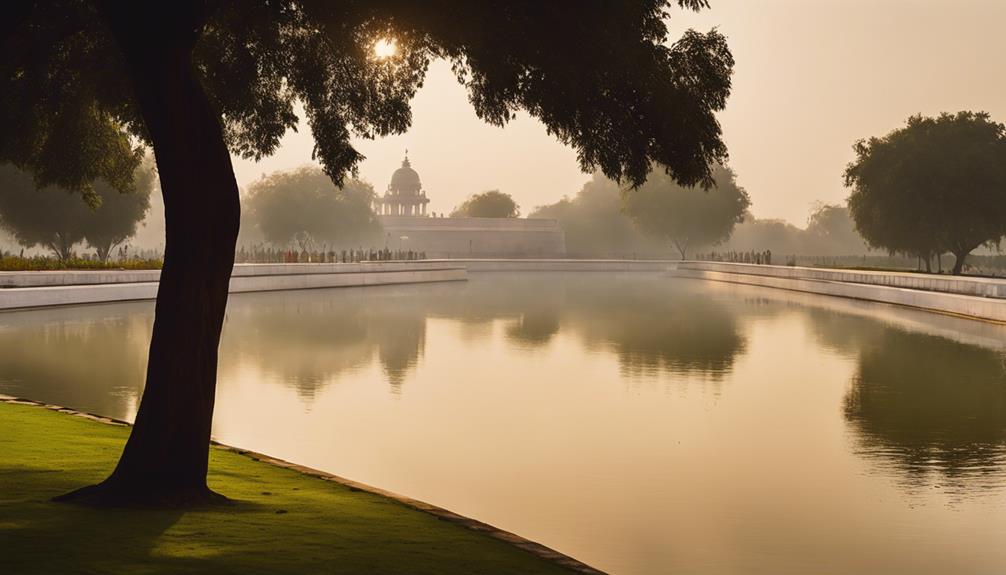
As you step into Raj Ghat, the serene atmosphere envelops you, providing a tranquil escape from the chaos of Old Delhi. You'll find yourself drawn to the simple yet powerful memorial dedicated to Mahatma Gandhi, surrounded by lush greenery and a stunning view of the Yamuna River. Now, let's explore the details that make Raj Ghat a must-visit destination, from its historic significance to the best times to visit.
Overview
Raj Ghat's serene atmosphere envelops you in a sense of calm, transporting you to a world of tranquility amidst the chaos of Old Delhi. As you stroll through the lush green gardens, you'll discover a haven that pays tribute to India's rich history and cultural heritage. This iconic monument, nestled along the Yamuna River, is a monument to the city's storied past, reflecting the Mughal legacy that has shaped Delhi's urban planning and architecture.
As you explore Raj Ghat, you'll gain a deeper understanding of Old Delhi's history and its significance in Indian heritage. The memorial's design and layout reflect the city's cultural evolution, blending traditional and modern elements. You'll notice how the complex's urban planning and design have been influenced by the city's development over the centuries. The peaceful ambiance of Raj Ghat serves as a poignant reminder of the importance of preserving our cultural legacy, even as the city continues to evolve and grow.
Mahatma Gandhi's Memorial Flame
Step into the serene atmosphere of Raj Ghat, and you're immediately drawn to the Eternal Flame, a beacon of peace that flickers gently in tribute to Mahatma Gandhi's enduring legacy. As you walk towards the memorial, you can't help but feel a sense of reverence for the man who played a pivotal role in India's struggle for independence. Gandhi's philosophy of non-violent resistance, which emphasized love, compassion, and self-sacrifice, is palpable in the tranquil ambiance of Raj Ghat. You can almost hear the echoes of his iconic phrases, "Be the change you wish to see in the world" and "An eye for an eye only ends up making the whole world blind." The memorial, surrounded by lush greenery, serves as a poignant reminder of Gandhi's unwavering commitment to Indian Independence. As you pay your respects, you're reminded of the power of peaceful protest and the importance of standing up for what you believe in. Take a moment to reflect on Gandhi's remarkable journey and the impact he had on shaping India's destiny.
Best Time To Visit
You'll want to time your visit to Raj Ghat strategically, as the peaceful ambiance of this iconic memorial can be greatly enhanced by the time of day and year you choose to visit. The best time to visit Raj Ghat is during the winter months (October to February), when the weather conditions are mild and pleasant, making it ideal for a stroll along the serene surroundings. Avoid visiting during the peak tourist season (June to August), when the scorching heat and humidity can be overwhelming. Additionally, try to avoid planning your visit during peak months (December to January), when the memorial is crowded with tourists and locals alike. Be mindful of travel restrictions, such as Republic Day (January 26th) and Independence Day (August 15th), when the memorial might be closed to visitors. To truly experience the tranquil atmosphere of Raj Ghat, plan your visit during the early morning or late evening, when the crowds are thinner, and you can soak in the peaceful ambiance without distractions.
Wear Comfortable Walking Sandals
As you prepare to immerse yourself in Raj Ghat's serene atmosphere, slip into comfortable walking sandals that will be your trusted companions throughout your stroll. You'll be grateful for the support and comfort they provide as you explore the lush gardens and tranquil surroundings. With Raj Ghat's sprawling grounds, you'll likely be doing a fair amount of walking, so prioritize sole protection. Look for sandals with cushioning, arch support, and a sturdy sole to keep your feet happy.
Innovations in footwear technology have made walking sandals more comfortable and durable than ever. Many modern designs feature breathable materials, adjustable straps, and slip-resistant soles, ensuring you can walk confidently and carefree. Whether you opt for sleek and minimalist or bold and colorful, your comfortable walking sandals will be the perfect accompaniment to your Raj Ghat adventure. With your feet happy and supported, you'll be free to soak up the peaceful ambiance and reflect on the significance of this historic site.
St James Church's Gothic Spire
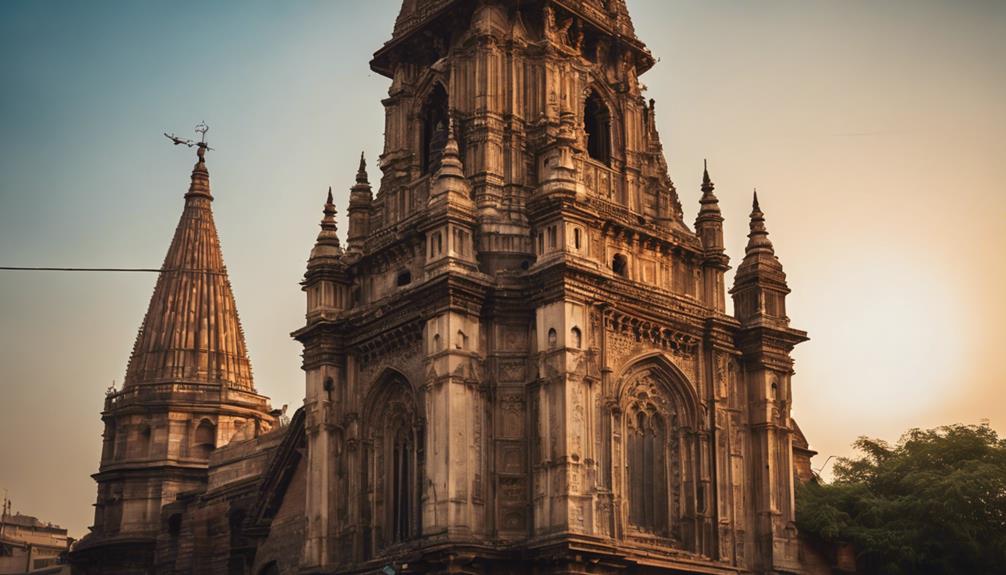
As you step into St James Church, you'll be struck by the grandeur of its Gothic spire, a soaring masterpiece that dominates the Old Delhi skyline. Now, get ready to explore the intricate details that make this landmark truly special. From the kaleidoscope of colors in its beautiful stained glass windows to the best times to visit, you'll discover the secrets that make St James Church a must-visit destination.
Overview
Rising majestically above the Old Delhi landscape, the Gothic spire of St James Church pierces the sky, a striking monument to the city's rich cultural heritage. As you walk towards the church, you'll notice the unique blend of Gothic and Romanesque styles, an embodiment of the city's eclectic architectural influences. Designed by E.C. Henings, the church showcases a blend of British and Indian styles, reflecting the city's fascinating Church History. Built in 1836, St James Church is a significant part of Delhi's Heritage, offering a glimpse into the city's rich cultural and historical significance.
As you step inside, you'll be struck by the intricate stone carvings, stunning stained-glass windows, and ornate furnishings. The church's interior is a treasure trove of architectural and artistic delights, making it a must-visit destination for history buffs and architecture enthusiasts. Today, St James Church remains a place of worship and a popular tourist attraction, inviting you to experience the rich cultural heritage of Old Delhi.
Beautiful Stained Glass Windows
You'll be mesmerized by the kaleidoscope of colors that dance across the church's interior, filtering in through the exquisite stained glass windows that adorn St James Church, a hallmark of its Gothic architecture. As you step inside, you'll be struck by the intricate designs and biblical scenes that adorn the windows, showcasing the exceptional craftsmanship of the era's skilled artisans. The church's stunning stained glass windows are a demonstration of the mastery of glassmaking techniques, where each piece is carefully crafted to refract light and create a kaleidoscope of colors. The restored interior, including the stained glass windows, maintains its original charm and historical significance, making it a must-visit attraction in Old Delhi. The beautiful stained glass windows are a tranquil oasis amidst the bustling streets of the historic city, offering a serene ambiance that's perfect for contemplation and reflection. With its stunning Church Architecture and breathtaking stained glass windows, St James Church is an unmissable destination in Old Delhi.
Best Time To Visit
Visiting St James Church's iconic Gothic spire is best during the early morning or late afternoon, when the soft, golden light of the sun accentuates the intricate carvings and ornate details, making for a truly unforgettable experience. You'll want to plan your visit according to the weather forecast, as the church's beauty is particularly striking on clear, sunny days. The best time to visit is during the tourist season, from October to March, when the climate conditions are mild and pleasant. Try to avoid peak hours, usually between 11 am and 3 pm, when the church is busiest. If you can, plan your visit during the holiday seasons, when the church is adorned with festive decorations, adding to its already impressive beauty. Keep in mind that the church may be closed during certain holidays, so it's a good idea to check the schedule beforehand. By planning your visit carefully, you'll be able to fully appreciate the stunning architecture and beauty of St James Church's Gothic spire.
Avoid Crowded Prayer Times
By timing your visit to St James Church's Gothic spire strategically, you can sidestep the throngs of worshippers that flock to the church during prayer times, allowing yourself a more peaceful and contemplative experience. To avoid the crowds, consider visiting early in the morning or late in the evening, when the church is less bustling. During these calm morning hours, you can indulge in quiet reflection, taking in the stunning architecture and serene atmosphere of the church. As you wander through the interior, you'll notice the intricate stained-glass windows, ornate pews, and striking altar, all of which contribute to the church's tranquil ambiance. By avoiding prayer times, you can fully appreciate the beauty and history of St James Church, making for a more intimate and meaningful experience. So, plan your visit wisely, and you'll be rewarded with a sense of calm and connection in this oasis amidst Old Delhi's chaos.
Khari Baoli's Ancient Steps
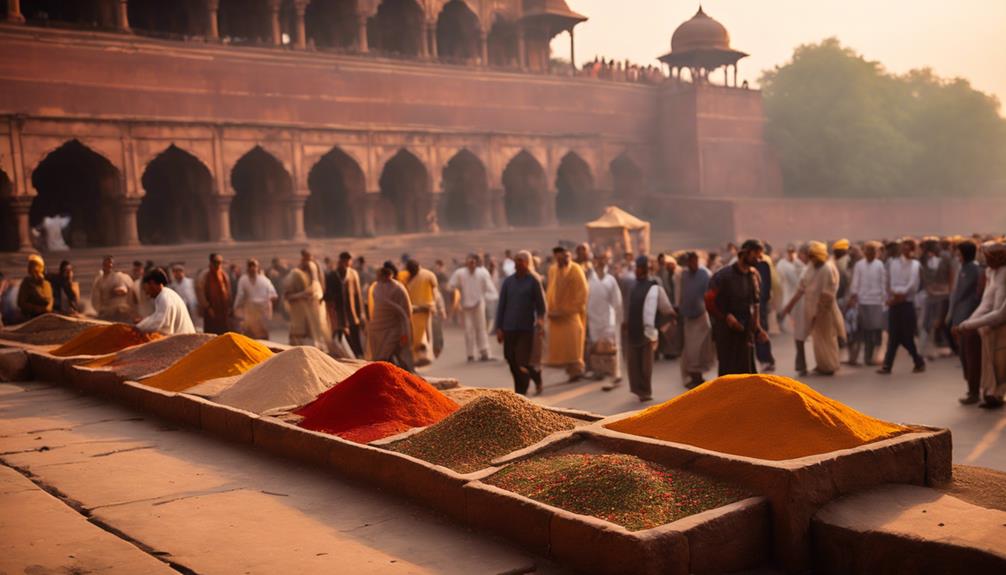
As you step into Khari Baoli's Ancient Steps, you'll venture on a journey through time, surrounded by the sights, sounds, and aromas of one of Old Delhi's oldest and busiest markets. You're about to discover the secrets of this ancient spice trading hub, where merchants once came from far and wide to exchange exotic goods. Get ready to explore the labyrinthine alleys, uncover the best times to visit, and learn why comfortable shoes are a must-have for this unforgettable adventure.
Overview
Step into Khari Baoli's ancient streets, and you're immediately enveloped in a kaleidoscope of colors, aromas, and sounds that will leave you mesmerized and keen to explore every nook and cranny of this historic market. As one of the oldest and busiest markets in Old Delhi, Khari Baoli offers a diverse range of goods, from spices and dry fruits to nuts and souvenirs. The market's evolution is a reflection of its cultural significance, with its ancient steps leading to a maze of narrow alleys and shops that showcase the rich history of the area.
As you wander through the market, you'll be struck by the vibrant colors, enticing aromas, and cacophonous sounds that create a sensory overload. But amidst the chaos, you'll discover hidden gems and unique experiences that will leave you with unforgettable memories. With its rich history and cultural significance, Khari Baoli is a must-visit destination for anyone exploring Old Delhi. Whether you're a foodie, a shopaholic, or a history buff, this market has something for everyone, making it an unforgettable experience that will leave you wanting more.
Ancient Spice Trading Hub
Winding your way up Khari Baoli's ancient steps, you'll uncover the remnants of a centuries-old spice trading hub, where merchants once haggled over prized commodities like saffron and cardamom. The air is thick with the aromas of cumin, coriander, and turmeric, transporting you back in time to an era when spice caravans traversed the merchant routes of the ancient Silk Road. As you explore the narrow alleys and cramped shops, you'll discover a treasure trove of spices, teas, and dried fruits, showcasing the rich cultural heritage of Old Delhi.
The spice traders of yesteryear would have traversed the same streets, their camel-drawn caravans laden with precious cargo from far-flung lands. The whispers of haggling merchants and the clinking of copper utensils against wooden scales still echo through the passageways, evoking the vibrant atmosphere of a bygone era. Today, Khari Baoli remains a hub of spice trading activity, with vendors and merchants continuing the ancient traditions of their forebears. As you wander through the labyrinthine streets, you'll uncover the secrets of this ancient spice trading hub, where the aromas of the past mingle with the sounds of the present.
Best Time To Visit
You'll want to plan your visit to Khari Baoli's ancient steps during the early morning or late afternoon, when the golden light of the sun casts a warm glow over the spice-scented alleys. These timings offer a respite from the scorching Summer mornings, when the sun beats down relentlessly. During the Monsoon seasons, the ancient steps come alive with the sound of raindrops and the aroma of wet earth. If you're visiting during Winter evenings, you'll be treated to a magical atmosphere, with twinkling lights illuminating the alleys. It's best to avoid visiting during Festive holidays, when the crowds can be overwhelming. If you can, try to avoid Peak hours, when the alleys are packed with locals and tourists alike. By planning your visit strategically, you'll be able to soak in the rich history and vibrant culture of Khari Baoli's ancient steps, without the chaos and noise. With a little planning, you'll be able to experience the authentic charm of this ancient spice trading hub.
Wear Comfortable Climbing Shoes
Two hundred steep, narrow steps await you at Khari Baoli's ancient trading hub, and tackling them in comfortable climbing shoes is essential to fully immerse yourself in this historic spice market. You're not climbing mountain peaks, but the stairs can be just as intimidating, especially in the thick of summer. Imagine traversing hiking trails with uneven terrain, and you'll get an idea of what to expect. The last thing you want is to be distracted by blisters or sore feet when you're surrounded by the vibrant colors and enticing aromas of India's largest spice market.
Wearing comfortable climbing shoes will allow you to focus on the sights and sounds around you. You'll be able to climb the stairs with confidence, taking in the stunning views of the old city as you ascend. And when you finally reach the top, you'll be rewarded with breathtaking vistas of the surrounding rooftops and the bustling streets below. So, don't let uncomfortable shoes hold you back – lace up your sturdy climbing shoes and get ready to conquer Khari Baoli's ancient steps in style!
Fatehpuri Masjid's Historic Gates
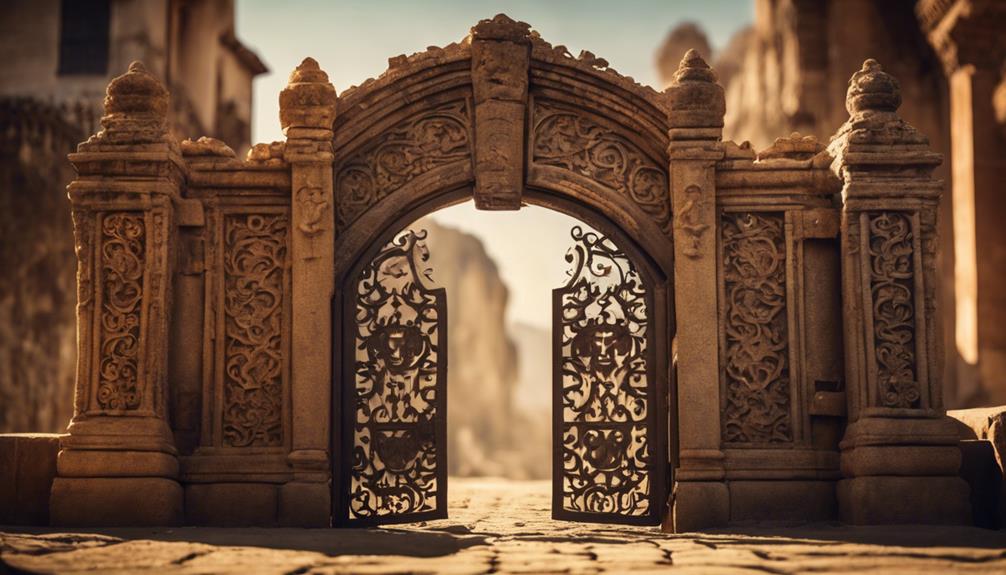
As you step through the historic gates of Fatehpuri Masjid, you'll be struck by the stunning architecture that surrounds you. You'll want to take a closer look at the intricate marble inlay work that adorns the walls, a demonstration of the skill of the artisans who built this beautiful mosque. Before you start exploring, though, it's a good idea to plan your visit carefully, avoiding crowded prayer hours to get the most out of your experience.
Overview
Standing majestically amidst the bustling streets of Old Delhi, Fatehpuri Masjid's historic gates serve as a monument to the region's rich cultural heritage, beckoning visitors to explore the intricate history hidden within its ancient walls. As you step through the gates, you're transported to a bygone era, surrounded by the vibrant hues of Old Delhi's urban landscape. The masjid's historical significance is palpable, a symbol of the city's architectural evolution. You can almost smell the aroma of traditional spices wafting from the nearby markets, enticing you to sample the local cuisine. As you wander through the surrounding alleys, the sounds of vendors calling out their daily specials and the clinking of tea cups in the local chai stalls create a sensory experience like no other. Fatehpuri Masjid is more than just a mosque – it's a gateway to understanding Delhi's cultural heritage. By exploring this iconic landmark, you'll uncover the intricate threads that weave Old Delhi's history, culture, and architecture together.
Intricate Marble Inlay Work
Beyond the mosque's grand entrance, the intricate marble inlay work on Fatehpuri Masjid's historic gates beckons you to pause, its intricate patterns and designs woven together with precision and craftsmanship. As you step closer, you'll be mesmerized by the level of detail and expertise that has gone into creating these stunning gates. The Mughal craftsmanship is evident in every aspect of the design, showcasing the skill of the artisans who built this beautiful mosque in 1650.
The marble artistry on display is truly breathtaking, with delicate patterns and designs that seem to dance across the gates. You'll notice the blend of Indian, Persian, and Arabic styles, a reflection of the cultural exchange and diversity of the Mughal Empire. The gates are a masterpiece of marble inlay work, where thin slices of marble have been carefully arranged to create intricate designs and patterns. Take your time to appreciate the craftsmanship that has gone into creating these gates, and you'll be rewarded with a deeper understanding of the rich cultural heritage of Old Delhi.
Best Time To Visit
When is the best time to visit Fatehpuri Masjid's historic gates, and what can you expect from the experience? As you plan your trip to Old Delhi, consider the city's weather patterns to make the most of your visit. The best time to visit Fatehpuri Masjid's historic gates is during the winter months, from October to February, when the weather is mild and pleasant. You'll be comfortable exploring the masjid's intricate marble inlay work and admiring the stunning architecture without the scorching heat of the summer sun. Avoid visiting during the Summer Solstice, when the temperatures can soar up to 45°C (113°F). Additionally, Delhi's summer months are characterized by intense heatwaves, making it challenging to enjoy the masjid's peaceful atmosphere. By visiting during the winter, you'll be able to fully appreciate the majesty of Fatehpuri Masjid's historic gates without the distraction of sweltering heat.
Avoid Crowded Prayer Hours
As you plan your visit to Fatehpuri Masjid's historic gates, consider avoiding prayer hours when the devout throng the masjid, and instead, slip in during the quieter moments to fully absorb the serene atmosphere and intricate architectural details. You'll appreciate the tranquility that permeates the air, allowing you to focus on the stunning Mughal-era architecture and ornate carvings that adorn the walls. By avoiding prayer hours, you're also showing cultural sensitivity and travel etiquette, respecting the sacred space and the faithful who come to worship. Take a moment to observe the beautiful marble flooring, the intricate inlays, and the ornate domes that seem to touch the sky. As you wander through the masjid, remember to remove your shoes, dress modestly, and refrain from taking photos during prayer times. By being mindful of local customs and traditions, you'll not only enhance your own experience but also contribute to a more harmonious cultural exchange.
Gurudwara Sis Ganj Sahib
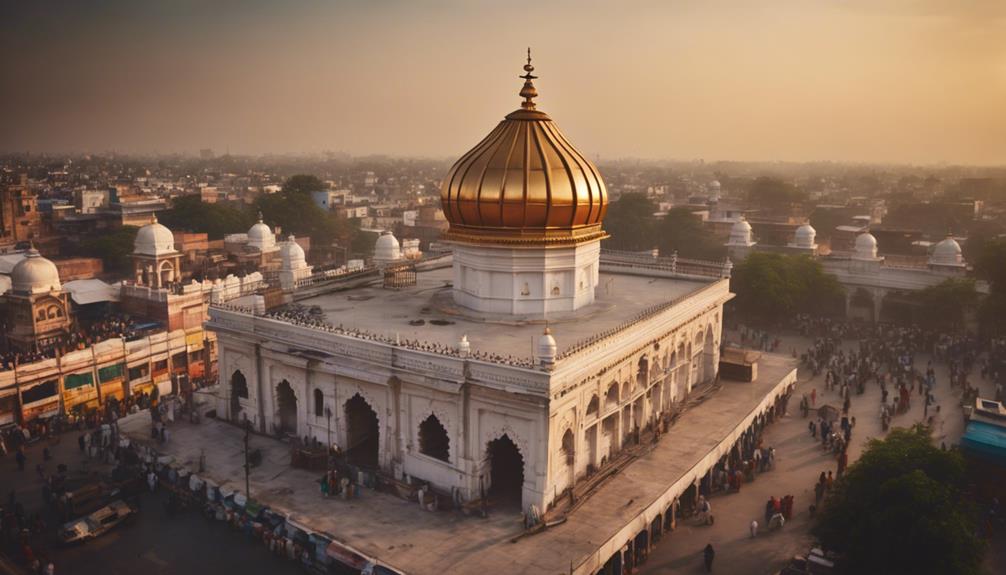
As you step into the serene atmosphere of Gurudwara Sis Ganj Sahib, you're surrounded by the rich history and spiritual significance of this sacred Sikh shrine. You'll have the opportunity to admire the beautifully crafted display case showcasing Sikh scriptures, and learn about the gurudwara's significance in the Sikh community. Before you begin your exploration, remember to remove your shoes as a sign of respect, and plan your visit according to the best times of the day to make the most of your experience.
Overview
Located in the heart of Old Delhi, Gurudwara Sis Ganj Sahib stands as a monument to the city's rich cultural heritage, its stunning architecture and spiritual significance drawing you in. As you step into this historic gurudwara, you'll be transported back in time to the Mughal era, when Old Delhi was a hub of cultural fusion. The gurudwara's intricate marble work, ornate domes, and majestic architecture are a reflection of the city's rich history. You'll be fascinated by the blend of Islamic and Sikh architectural styles, reflecting the city's eclectic past. As one of the oldest and most revered historical landmarks in Old Delhi, Gurudwara Sis Ganj Sahib is a must-visit tourist attraction. The gurudwara's significance extends beyond its stunning architecture; it's a symbol of the city's resilience and urban development. As you explore this sacred space, you'll uncover the secrets of Old Delhi's history, and experience the city's vibrant cultural heritage firsthand.
Sikh Scripture Display Case
Inside the Gurudwara Sis Ganj Sahib, you'll discover a magnificent Sikh Scripture Display Case, housing the sacred Guru Granth Sahib, the holy book of the Sikhs, which radiates an aura of reverence and spirituality. As you approach the display case, you're struck by the opulence of the golden relics adorning the sacred texts. The Guru Granth Sahib, considered the ultimate spiritual authority in Sikhism, is treated with utmost reverence, and its presence evokes a sense of calm and contemplation.
As you gaze upon the sacred texts, you can't help but feel a deep connection to the Sikh faith. The display case is beautifully crafted, with intricate designs and patterns that reflect the rich cultural heritage of the Sikhs. The Guru Granth Sahib is placed on a velvet pedestal, surrounded by golden ornaments and precious gems, adding to the sense of grandeur and majesty. The atmosphere is serene, and you can't help but feel a sense of peace wash over you as you stand before this magnificent display of Sikh scripture and heritage.
Best Time To Visit
You'll find the Gurudwara Sis Ganj Sahib at its most vibrant during the early morning and late evening hours, when the soft golden light of dawn and dusk filters through the intricate marble carvings, creating an otherworldly ambiance. As you walk through the complex, you'll feel the serenity of the gurudwara's peaceful atmosphere. Summer mornings are particularly lovely, with the warm sunlight casting a gentle glow on the temple's white marble. If you're looking to avoid the crowds, consider off-season travel, when the gurudwara takes on a more intimate, contemplative atmosphere. You'll have more space to explore, and the priests will be more available to answer your questions. Just be prepared for the heat, as Delhi's summers can be unforgiving. If you time your visit just right, you might even catch a glimpse of the priests performing a traditional Sikh ceremony, adding to the gurudwara's already enchanting atmosphere.
Remove Shoes Before Entering
As you approach the serene Gurudwara Sis Ganj Sahib, remember to slip off your shoes, leaving the hustle and bustle of Old Delhi's streets behind, and prepare to enter a domain of spiritual tranquility. This ancient Sikh temple, built in 1783, is a sacred space where devotees come to pay their respects and engage in sacred rituals. As you enter, you'll notice the vibrant colors and intricate architecture that adorn the temple's exterior, giving way to a sense of calm and serenity within. Be mindful of the cultural norms that govern this sacred space: remove your shoes and cover your head as a sign of respect. Take a moment to observe the devotees as they perform their daily prayers, their voices rising in harmonious chants. As you explore the temple, you'll find a langar, or community kitchen, where volunteers prepare meals for the community, embodying the spirit of selfless service. Step into this oasis of peace, and let the tranquility of Gurudwara Sis Ganj Sahib envelop you.
Indian War Memorial Museum
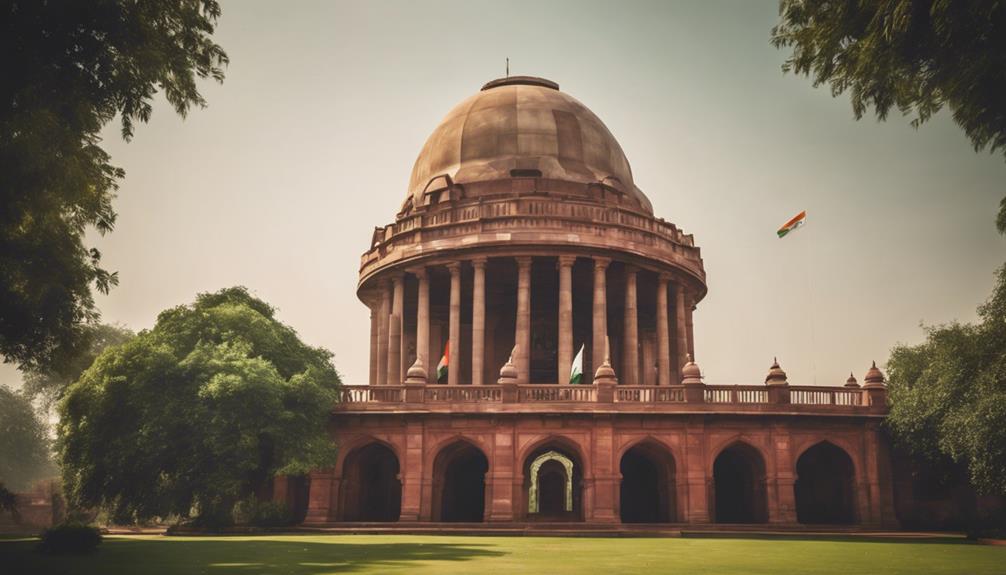
As you step into the Indian War Memorial Museum, you're about to venture on a journey through India's rich military history. You'll get up close and personal with the personal belongings of war heroes, and learn about the best times to visit this iconic museum. From the exhibits showcasing historic battles to the importance of respecting the artifacts on display, you'll want to soak up every detail of this fascinating museum.
Overview
Located within the majestic Red Fort, the Indian War Memorial Museum stands as a tribute to India's rich military history, showcasing an impressive array of arms, weapons, and other objects of war that have shaped the nation's past. As you step into the museum, you'll be transported back in time, with exhibits that highlight India's military history and cultural significance. One of the standout features is a miniature model of the war scene between Babur and Ibrahim Lodi, giving you a glimpse into the country's complex past. This relatively small but informative museum provides an exhaustive overview of India's military history, making it a must-visit for history buffs and those interested in the country's military heritage. With tickets available at the Red Fort ticket counter, you can plan your visit between 9:00 am and 5:00 pm. Take a step back in time and explore the Indian War Memorial Museum to gain a deeper understanding of India's rich cultural significance and military history.
War Heroes' Personal Belongings
You'll be struck by the poignant display of war heroes' personal belongings, carefully preserved and showcased alongside their stories of bravery and sacrifice. As you walk through the Indian War Memorial Museum, you'll be surrounded by the tangible remnants of battle-hardened warriors. The worn, faded uniforms, the battered helmets, and the dog-eared photographs all serve as mementos to the sacrifices made by those who fought for their country.
The war memorabilia on display is a poignant reminder of the battle scars that linger long after the guns fall silent. You'll see the personal effects of soldiers who fought in some of India's most pivotal battles, each item telling a story of courage, loyalty, and devotion. The museum's collection is a powerful tribute to the men and women who have fought for India's freedom and independence. As you explore the exhibits, you'll gain a deeper understanding of the human cost of war and the importance of preserving the memories of those who have served.
Best Time To Visit
Delhi's scorching summers and chilly winters dictate the best time to visit the Indian War Memorial Museum, which falls between October and March. During this period, the weather is pleasant, making it ideal for your visit. You'll love strolling through the museum's galleries on a crisp winter morning or a mild summer morning, enjoying the comfort of the gentle sun. Be sure to check the weather forecast beforehand to plan your day accordingly. This period also coincides with the tourist season, so be prepared for peak hours and larger crowds. However, if you're a solo traveler, consider visiting during the off-season (April to September) to snag some great deals on accommodations and tours. Keep in mind that climate change has led to unpredictable weather patterns, so stay flexible with your travel plans. As you plan your trip, take note of regional holidays and cultural festivals that may affect the museum's operating hours. With these travel tips, you'll be all set for a memorable visit to the Indian War Memorial Museum.
Avoid Touching Exhibits
As you wander through the galleries of the Indian War Memorial Museum, remember that your gentle touch can be a major threat to the centuries-old artifacts on display, and exercise restraint to preserve these historical treasures for generations to come. The museum's exhibits, including arms, ammunition, and military uniforms, are irreplaceable pieces of India's military history. To maintain their preservation, it's vital to avoid touching them, as the oils from your skin can cause damage over time. The museum's preservation methods, such as controlling temperature and humidity levels, are vital in maintaining the artifacts' longevity. However, artifact handling by visitors can compromise these efforts. By resisting the urge to touch, you'll be contributing to the preservation of these historical treasures. Your cooperation will help maintain the museum's collection, allowing future generations to appreciate India's rich military heritage. So, let's appreciate these artifacts from a respectful distance, making certain their preservation for years to come.
Frequently Asked Questions
What Is Purani Delhi Famous For?
As you step into Purani Delhi, you'll discover it's famous for its mouth-watering Street Food, which tantalizes your taste buds, and its Rich History, which whispers tales of the past, drawing you in with its vibrant charm.
Which Is Better, New Delhi or Old Delhi?
You're spoiled for choice between New Delhi's sleek, modern charm and Old Delhi's vibrant, traditional soul – do you crave a relaxed, urban lifestyle or a whirlwind of colorful chaos in the walled city?
How Many Places Are in Old Delhi?
You'll discover over 25 historic landmarks, 15 mosques, 20 historic havelis, and numerous hidden gems in Old Delhi, making it a treasure trove of history, architecture, and culture waiting to be explored and uncovered.
Is Chandni Chowk Worth Visiting?
You'll find Chandni Chowk's rich history and vibrant atmosphere utterly enchanting, with street food exploration that'll tantalize your taste buds, making it an absolute must-visit destination that'll leave you enchanted and hungry for more!
Conclusion
As you wander through the labyrinthine streets of Old Delhi, the city's rich history and vibrant culture unfold before your eyes. From the towering Qutub Minar to the peaceful Raj Ghat, each destination is a monument to the city's storied past. Remember, 'when in Rome, do as the Romans do' – immerse yourself in the local flavors, sounds, and aromas, and let Old Delhi's alluring charm leave you enchanted.
